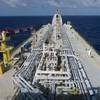Record high freight rates are creating more headaches for traders looking to house millions of barrels of unsold crude oil and who already face potential losses due to record high stocks.
They have to decide on whether to use tankers for longer term storage until they can sell their cargoes, or dump them at even more discounted prices in order to keep wells running.
This is expected to come at a bigger cost as rates for supertankers have soared - reaching their highest since 2008 at over $100,000 a day last month and currently around $70,000 a day.
Some have already been caught out with extra oil, and had no choice but to keep it on vessels. Trade sources said the expensive freight meant this was not a money-making play - and is unlikely to become one any time soon.
"They're losing money, and they want to place the vessel as fast as possible," said Eugene Lindell, senior crude market analyst with JBC. "It's putting pressure on anyone who has to take a vessel out."
Booking a supertanker on a one-year time charter has also spiked to over $50,000 a day - double the rate last year - with the overall monthly cost of storing oil on a vessel estimated at just over $2 million.
Hot Year for Tankers
A combination of bargain buying by oil importers and refineries and fewer new vessel deliveries this year meant that the tanker market was having its best year since the 2008 financial crisis, Omar Nokta with Clarksons Platou Securities said.
"Capacity utilisation has jumped sharply as a consequence, nearly reaching 90 percent, the highest level since 2008," Nokta said. "As seasonal factors now turn up, we expect to see more of the above with floating storage possibly becoming an even bigger factor."
Placing crude in storage is only profitable if prices for delivery in the future are at a large enough premium to the current levels - a market structure known as contango. The contango also has to be large enough to pay for the cost of storage, which is usually much higher on ships than land tanks.
Earlier this year, as much as 50 million barrels of oil was estimated to have been earmarked for sea storage options with traders looking to sell the cargoes later on at a profit.
That speculative play fizzled out as the contango flattened quickly.
"If it (a wide contango) gets there, it would be a very, very small amount of time ... before the freight rate goes up and it closes," one oil trader said. "(Tanker) owners are notoriously bad at hiking the rates in no time at all."
The trading strategy was last used in 2009, when slumping prices led traders to park more than 100 million barrels of oil on tankers at sea before stocks were sold off. At the time, oil tanker rates were at rock-bottom levels, and owners were keen for long-term leases.
This time round, tanker owners have the upper hand, with worldwide bottlenecks and heavy traffic to oil refineries keeping vessels fully booked.
(By Jonathan Saul and Libby George)













